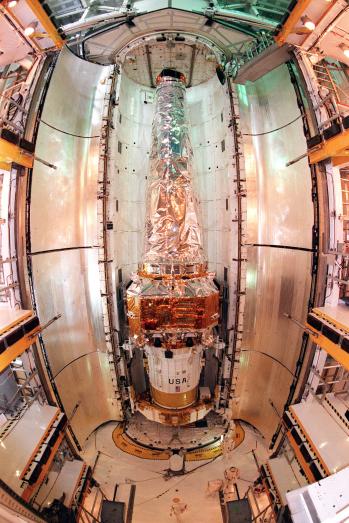Credit & Copyright: NASA
Explanation:
Wrapped in protective blankets and mounted atop an
Inertial Upper Stage (IUS) rocket,
the Chandra X-ray Telescope is
seen in this wide-angle view
before launch snuggled into the
space shuttle Columbia's payload bay.
Columbia's crew released
the telescope, named in honor of the late Nobel Laureate
Subrahmanyan Chandrasekhar,
into orbit on Friday, July 23rd,
where it is now undergoing check out and
activation of its scientific instruments.
To help realize its enormous potential for
exploration of the distant Universe at
X-ray energies, controllers
will perform a series
of firings in the coming days
which will eventually
boost the 10,000 pound telescope into a highly ecentric orbit.
In fact, the final working orbit for Chandra
will range from a close point of about 6,200 miles out
to 87,000 miles or one third of
the distance to the Moon.
The elongated orbit will carry Chandra's
sensitive
X-ray detectors beyond interference caused
by the Earth's
radiation belts allowing Chandra to make about 55 hours
of continuous observations per orbit.
The shuttle Colombia, commanded by
Eileen Collins is
scheduled to land this evening at
11:20 pm EDT at Kennedy Space Center.
Authors & editors:
Robert Nemiroff
(MTU) &
Jerry Bonnell
(USRA)
NASA Web Site Statements, Warnings,
and Disclaimers
NASA Official: Jay Norris.
Specific
rights apply.
A service of:
LHEA at
NASA /
GSFC
& Michigan Tech. U.
Based on Astronomy Picture
Of the Day
